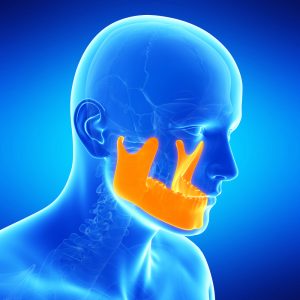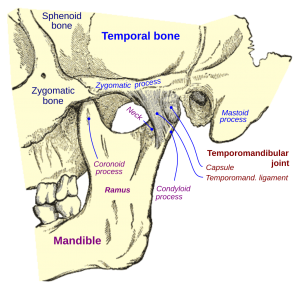Atypical earache is hint of moderate to severe damage in jaw joint (TMD)
A episodic non progressive earache that does not respond to antibiotic and has no inflammation in ear canal.
Atypical earache can be referred pain from moderate to severe damage jaw joint (TMD)
Repetitive trips to PCP or ENT for earache w/o infection or inflammation or slight inflammation w/o benefit from antibiotic, you have referred pain from TMD.
Atypical Symptoms:
- Periodic unilateral earaches
- Little to no inflammation ear canal
- Does not respond antibiotic
- No fever, malaise, chills
- Occasionally, Tinnitus
- Aggravated by open wide, chew, clench, grind, eat
- Mild, moderate, severe ear pain
Secondary hints:
- Jaw joint pain in same ear
- CT-Brain/Sinus: shows bony damage same TMD as painful ear
- MRI IAC-Brain: shows displaced disc in same TMD as painful ear
- Jaw Deviation to same side
- Moderate/coarse crepitus in TMD on that side
- Pior history jaw trauma or MVA's
Anatomical hints:
- Jaw joint pain is just in front of ear
- Outside ear is cartilage is adjacent to capsule TMD
- Swelling inside TMD can press ear canal
- Inside ear canal is thick bone
- Alignment connects medial tissues of TMD to inside ear a) Anterior Malleolar Ligament b) Completely displaced disc
- TMD get damaged in MVA as much as neck joints
ENT difficulty w/ Atypical Earache?
1) Little time was spent in ENT school on jaw joint 2) ENT assumes dentistry covers TMD 3) Dental school left TMD out dental training 3) Cross over pathologies are poorly manged in all fields 4) Insurance doesn't cover interdisplicinary communication 5) Orofacial Pain Specialist referrals are difficult cross dental medical fields 6) Patients looking for quick fix do not honor/trust referral 7) Patient have trouble understanding referred pain
Moderate to severe damage in jaw joint referring into ear:
- complete displaced disc &
- osteoarthritis TMD
Hints moderate/severe jaw joint damage:
- Moderate grinding
- Tension Headaches
- Deviation opening to side ear pain
- Broken teeth, crowns, implants
- Joint noises
- High anxiety
- History earaches w/o infection
- IBS, Reflux, GERD
- Recession, Cervical erosion, sensitivity
- Ear pain is Aggravated chewing
- History locking
- Multiple Biteguards or Nightguards
- Can only open 1 finger
Tinnitus rarely associated w/ TMD
- 6% patients have anterior malleolar ligament (AML)
- 2% AML patients have DDw/oR
- Completely Displaced Disc displacement pulls on AML
- ENT should be 1st choice in any tinnitus case
- If TMD symptoms are present, a referral Orofacial Pain Specialist
- If AML & DDw/oR are present, some improvement tinnitus may occur
- ORPS & team provides chewing system orthopedics for benefit tinnitus
- If you have both AML-DDw/oR tinnitus is associated w/ TMD
Disc displacement was found to be present in ipsilateral joint in all 53 patients w/ unilateral tinnitus. (Ren &Isberg. J. CranioPrac 1995 13:75)
Second source of Atypical Earache 1) Chewing muscle can refer into ear Lateral Pterygoid 2) Neck muscles can refer into ear SCM Vertebral muscles C1-C2
TINNITUS
- Most causes of tinnitus poorly researched
- Tinnitus can be associated with TMD
- Most of known causes tinnitus are medical
- Two conditions must exist for relationship TMD:
a) Completely displaced disc
b) Anterior Malleollar Ligament



